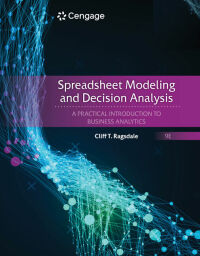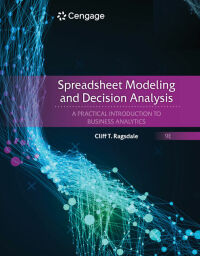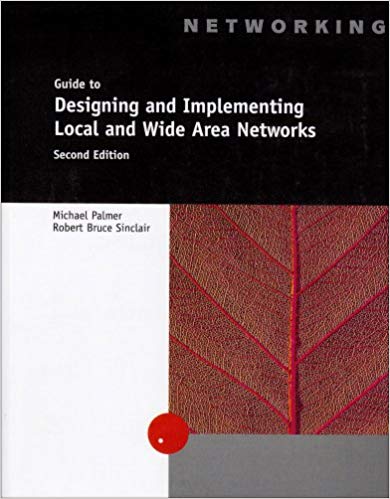Spreadsheet Modeling and Decision Analysis A Practical Introduction to Business Analytics, 9th Edition Test bank
PRINT ISBN: 9780357132098, 0357132092, ETEXT ISBN: 9798214353142
Do you need test banks fast? eTestBank.net is the best test bank website for you! Download your test bank right after you pay. No waiting!
Why eTestBank.net is Great:
✅ Instant Download:
Get your test bank right away after payment.
✅ Unlimited Downloads:
Download your test bank anytime and as many times as you want.
✅ 24/7 Live Help:
We are here to help you all day, every day.
✅ Guaranteed Delivery:
If you don’t get the download right away, we will send it to you in 3 to 6 hours.
How to Get Your Test Bank:
- Pick Your Test Bank: Choose from many test banks.
- Pay Safely: Pay securely on eTestBank.net.
- Download Instantly: Get your test bank immediately after payment.
- Download Anytime: Unlimited downloads whenever you need them.
Need Help? Contact Us:
📧 Email: [Support@etestbank.net]
📱 WhatsApp: [https://wa.me/message/MC222DLQ4GDXL1r]
Didn’t Get Your Download?
Don’t worry! If you don’t get the file right away, we’ll send it to you in 3 to 6 hours. Need it sooner? Contact us by email or WhatsApp.
💡 Buy now from eTestBank.net for instant downloads, unlimited access, and 24/7 support—get your test bank today!
Table of contents for Spreadsheet Modeling Test Bank
- Cover Page
- Title Page
- Copyright Page
- Dedication
- Frontline Solvers
- Preface
- Acknowledgments
- Chapter 1. Introduction to Modeling and Decision Analysis
- 1-0. Introduction
- 1-1. The Modeling Approach to Decision-Making
- 1-2. Characteristics and Benefits of Modeling
- 1-3. Mathematical Models
- 1-4. Categories of Mathematical Models
- 1-5. Business Analytics and the Problem-Solving Process
- 1-6. Anchoring and Framing Effects
- 1-7. Good Decisions vs. Good Outcomes
- 1-8. Summary
- 1-9. References
- The World of Business Analytics: Microsoft Excel Can Help You Learn More about Analytics than You Might Realize
- Questions and Problems
- Case 1-1. Patrick’s Paradox
- Chapter 2. Introduction to Optimization and Linear Programming
- 2-0. Introduction
- 2-1. Applications of Mathematical Optimization
- 2-2. Characteristics of Optimization Problems
- 2-3. Expressing Optimization Problems Mathematically
- 2-3a. Decisions
- 2-3b. Constraints
- 2-3c. Objective
- 2-4. Mathematical Programming Techniques
- 2-5. An Example LP Problem
- 2-6. Formulating LP Models
- 2-6a. Steps in Formulating an LP Model
- 2-7. Summary of the LP Model for the Example Problem
- 2-8. The General Form of an LP Model
- 2-9. Solving LP Problems: An Intuitive Approach
- 2-10. Solving LP Problems: A Graphical Approach
- 2-10a. Plotting the First Constraint
- 2-10b. Plotting the Second Constraint
- 2-10c. Plotting the Third Constraint
- 2-10d. The Feasible Region
- 2-10e. Plotting the Objective Function
- 2-10f. Finding the Optimal Solution Using Level Curves
- 2-10g. Finding the Optimal Solution by Enumerating the Corner Points
- 2-10h. Summary of Graphical Solution to LP Problems
- 2-10i. Understanding How Things Change
- 2-11. Special Conditions in LP Models
- 2-11a. Alternate Optimal Solutions
- 2-11b. Redundant Constraints
- 2-11c. Unbounded Solutions
- 2-11d. Infeasibility
- 2-12. Summary
- 2-13. References
- Questions and Problems
- Case 2-1. For the Lines They Are A-Changin’ (with apologies to Bob Dylan)
- Chapter 3. Modeling and Solving LP Problems in a Spreadsheet
- 3-0. Introduction
- 3-1. Spreadsheet Solvers
- 3-2. Solving LP Problems in a Spreadsheet
- 3-3. The Steps in Implementing an LP Model in a Spreadsheet
- 3-4. A Spreadsheet Model for the Blue Ridge Hot Tubs Problem
- 3-4a. Organizing the Data
- 3-4b. Representing the Decision Variables
- 3-4c. Representing the Objective Function
- 3-4d. Representing the Constraints
- 3-4e. Representing the Bounds on the Decision Variables
- 3-5. How Solver Views the Model
- 3-6. Using Analytic Solver
- 3-6a. Defining the Objective Cell
- 3-6b. Defining the Variable Cells
- 3-6c. Defining the Constraint Cells
- 3-6d. Defining the Nonnegativity Conditions
- 3-6e. Reviewing the Model
- 3-6f. Other Options
- 3-6g. Solving the Problem
- 3-7. Using Excel’s Built-in Solver
- 3-8. Goals and Guidelines for Spreadsheet Design
- 3-9. Make vs. Buy Decisions
- 3-9a. Defining the Decision Variables
- 3-9b. Defining the Objective Function
- 3-9c. Defining the Constraints
- 3-9d. Implementing the Model
- 3-9e. Solving the Problem
- 3-9f. Analyzing the Solution
- 3-10. An Investment Problem
- 3-10a. Defining the Decision Variables
- 3-10b. Defining the Objective Function
- 3-10c. Defining the Constraints
- 3-10d. Implementing the Model
- 3-10e. Solving the Problem
- 3-10f. Analyzing the Solution
- 3-11. A Transportation Problem
- 3-11a. Defining the Decision Variables
- 3-11b. Defining the Objective Function
- 3-11c. Defining the Constraints
- 3-11d. Implementing the Model
- 3-11e. Heuristic Solution for the Model
- 3-11f. Solving the Problem
- 3-11g. Analyzing the Solution
- 3-12. A Blending Problem
- 3-12a. Defining the Decision Variables
- 3-12b. Defining the Objective Function
- 3-12c. Defining the Constraints
- 3-12d. Some Observations about Constraints, Reporting, and Scaling
- 3-12e. Re-Scaling the Model
- 3-12f. Implementing the Model
- 3-12g. Solving the Problem
- 3-12h. Analyzing the Solution
- 3-13. A Production and Inventory Planning Problem
- 3-13a. Defining the Decision Variables
- 3-13b. Defining the Objective Function
- 3-13c. Defining the Constraints
- 3-13d. Implementing the Model
- 3-13e. Solving the Problem
- 3-13f. Analyzing the Solution
- 3-14. A Multiperiod Cash Flow Problem
- 3-14a. Defining the Decision Variables
- 3-14b. Defining the Objective Function
- 3-14c. Defining the Constraints
- 3-14d. Implementing the Model
- 3-14e. Solving the Problem
- 3-14f. Analyzing the Solution
- 3-14g. Modifying the Taco-Viva Problem to Account for Risk (Optional)
- 3-14h. Implementing the Risk Constraints
- 3-14i. Solving the Problem
- 3-14j. Analyzing the Solution
- 3-15. Data Envelopment Analysis
- 3-15a. Defining the Decision Variables
- 3-15b. Defining the Objective
- 3-15c. Defining the Constraints
- 3-15d. Implementing the Model
- 3-15e. Solving the Problem
- 3-15f. Analyzing the Solution
- 3-16. Summary
- 3-17. References
- The World of Business Analytics: Optimizing Production, Inventory, and Distribution at Kellogg
- Questions and Problems
- Case 3-1. Putting the Link in the Supply Chain
- Case 3-2. Foreign Exchange Trading at Baldwin Enterprises
- Case 3-3. The Wolverine Retirement Fund
- Case 3-4. Saving the Manatees
- Chapter 4. Sensitivity Analysis and the Simplex Method
- 4-0. Introduction
- 4-1. The Purpose of Sensitivity Analysis
- 4-2. Approaches to Sensitivity Analysis
- 4-3. An Example Problem
- 4-4. The Answer Report
- 4-5. The Sensitivity Report
- 4-5a. Changes in the Objective Function Coefficients
- 4-5b. A Comment about Constancy
- 4-5c. Alternate Optimal Solutions
- 4-5d. Changes in the RHS Values
- 4-5e. Shadow Prices for Nonbinding Constraints
- 4-5f. A Note about Shadow Prices
- 4-5g. Shadow Prices and the Value of Additional Resources
- 4-5h. Other Uses of Shadow Prices
- 4-5i. The Meaning of the Reduced Costs
- 4-5j. Analyzing Changes in Constraint Coefficients
- 4-5k. Simultaneous Changes in Objective Function Coefficients
- 4-5l. A Warning about Degeneracy
- 4-6. Ad Hoc Sensitivity Analysis
- 4-6a. Creating Spider Plots and Tables
- 4-6b. Creating a Solver Table
- 4-6c. Comments
- 4-7. Robust Optimization
- 4-8. The Simplex Method
- 4-8a. Creating Equality Constraints Using Slack Variables
- 4-8b. Basic Feasible Solutions
- 4-8c. Finding the Best Solution
- 4-9. Summary
- 4-10. References
- The World of Business Analytics: Fuel Management and Allocation Model Helps National Airlines Adapt to Cost and Supply Changes
- Questions and Problems
- Case 4-1. A Nut Case
- Case 4-2. Parket Sisters
- Case 4-3. Kamm Industries
- Chapter 5. Network Modeling
- 5-0. Introduction
- 5-1. The Transshipment Problem
- 5-1a. Characteristics of Network Flow Problems
- 5-1b. The Decision Variables for Network Flow Problems
- 5-1c. The Objective Function for Network Flow Problems
- 5-1d. The Constraints for Network Flow Problems
- 5-1e. Implementing the Model in a Spreadsheet
- 5-1f. Analyzing the Solution
- 5-2. The Shortest Path Problem
- 5-2a. An LP Model for the Example Problem
- 5-2b. The Spreadsheet Model and Solution
- 5-2c. Network Flow Models and Integer Solutions
- 5-3. The Equipment Replacement Problem
- 5-3a. The Spreadsheet Model and Solution
- 5-4. Transportation/Assignment Problems
- 5-5. Generalized Network Flow Problems
- 5-5a. Formulating an LP Model for the Recycling Problem
- 5-5b. Implementing the Model
- 5-5c. Analyzing the Solution
- 5-5d. Generalized Network Flow Problems and Feasibility
- 5-6. Maximal Flow Problems
- 5-6a. An Example of a Maximal Flow Problem
- 5-6b. The Spreadsheet Model and Solution
- 5-7. Special Modeling Considerations
- 5-8. Minimal Spanning Tree Problems
- 5-8a. An Algorithm for the Minimal Spanning Tree Problem
- 5-8b. Solving the Example Problem
- 5-9. Summary
- 5-10. References
- The World of Business Analytics: Yellow Freight System Boosts Profits and Quality with Network Optimization
- Questions and Problems
- Case 5-1. Hamilton & Jovanovich
- Case 5-2. Old Dominion Energy
- Case 5-3. US Express
- Case 5-4. The Major Electric Corporation
- Chapter 6. Integer Linear Programming
- 6-0. Introduction
- 6-1. Integrality Conditions
- 6-2. Relaxation
- 6-3. Solving the Relaxed Problem
- 6-4. Bounds
- 6-5. Rounding
- 6-6. Stopping Rules
- 6-7. Solving ILP Problems Using Solver
- 6-8. Other ILP Problems
- 6-9. An Employee Scheduling Problem
- 6-9a. Defining the Decision Variables
- 6-9b. Defining the Objective Function
- 6-9c. Defining the Constraints
- 6-9d. A Note about the Constraints
- 6-9e. Implementing the Model
- 6-9f. Solving the Model
- 6-9g. Analyzing the Solution
- 6-10. Binary Variables
- 6-11. A Capital Budgeting Problem
- 6-11a. Defining the Decision Variables
- 6-11b. Defining the Objective Function
- 6-11c. Defining the Constraints
- 6-11d. Setting up the Binary Variables
- 6-11e. Implementing the Model
- 6-11f. Solving the Model
- 6-11g. Comparing the Optimal Solution to a Heuristic Solution
- 6-12. Binary Variables and Logical Conditions
- 6-13. The Line Balancing Problem
- 6-13a. Defining the Decision Variables
- 6-13b. Defining the Constraints
- 6-13c. Defining the Objective
- 6-13d. Implementing the Model
- 6-13e. Analyzing the Solution
- 6-13f. Extension
- 6-14. The Fixed-Charge Problem
- 6-14a. Defining the Decision Variables
- 6-14b. Defining the Objective Function
- 6-14c. Defining the Constraints
- 6-14d. Determining Values for “Big M”
- 6-14e. Implementing the Model
- 6-14f. Solving the Model
- 6-14g. Analyzing the Solution
- 6-14h. A Comment on if( ) Functions
- 6-15. Minimum Order/Purchase Size
- 6-16. Quantity Discounts
- 6-16a. Formulating the Model
- 6-16b. The Missing Constraints
- 6-17. A Contract Award Problem
- 6-17a. Formulating the Model: The Objective Function and Transportation Constraints
- 6-17b. Implementing the Transportation Constraints
- 6-17c. Formulating the Model: The Side Constraints
- 6-17d. Implementing the Side Constraints
- 6-17e. Solving the Model
- 6-17f. Analyzing the Solution
- 6-18. The Branch-and-Bound Algorithm (Optional)
- 6-18a. Branching
- 6-18b. Bounding
- 6-18c. Branching Again
- 6-18d. Bounding Again
- 6-18e. Summary of B&B Example
- 6-19. Summary
- 6-20. References
- The World of Business Analytics: Who Eats the Float?—Maryland National Improves Check Clearing Operations and Cuts Costs
- Questions and Problems
- Case 6-1. Optimizing a Timber Harvest
- Case 6-2. Power Dispatching at Old Dominion
- Case 6-3. The MasterDebt Lockbox Problem
- Case 6-4. Removing Snow in Montreal
- Chapter 7. Goal Programming and Multiple Objective Optimization
- 7-0. Introduction
- 7-1. Goal Programming
- 7-2. A Goal Programming Example
- 7-2a. Defining the Decision Variables
- 7-2b. Defining the Goals
- 7-2c. Defining the Goal Constraints
- 7-2d. Defining the Hard Constraints
- 7-2e. GP Objective Functions
- 7-2f. Defining the Objective
- 7-2g. Implementing the Model
- 7-2h. Solving the Model
- 7-2i. Analyzing the Solution
- 7-2j. Revising the Model
- 7-2k. Trade-Offs: The Nature of GP
- 7-3. Comments about Goal Programming
- 7-4. Multiple Objective Optimization
- 7-5. An MOLP Example
- 7-5a. Defining the Decision Variables
- 7-5b. Defining the Objectives
- 7-5c. Defining the Constraints
- 7-5d. Implementing the Model
- 7-5e. Determining Target Values for the Objectives
- 7-5f. Summarizing the Target Solutions
- 7-5g. Determining a GP Objective
- 7-5h. The Minimax Objective
- 7-5i. Implementing the Revised Model
- 7-5j. Solving the Model
- 7-6. Comments on MOLP
- 7-7. Summary
- 7-8. References
- The World of Business Analytics: Truck Transport Corporation Controls Costs and Disruptions While Relocating a Terminal
- Questions and Problems
- Case 7-1. Removing Snow in Montreal
- Case 7-2. Planning Diets for the Food Stamp Program
- Case 7-3. Sales Territory Planning at Caro-Life
- Chapter 8. Nonlinear Programming and Evolutionary Optimization
- 8-0. Introduction
- 8-1. The Nature of NLP Problems
- 8-2. Solution Strategies for NLP Problems
- 8-3. Local vs. Global Optimal Solutions
- 8-4. Economic Order Quantity Models
- 8-4a. Implementing The Model
- 8-4b. Solving the Model
- 8-4c. Analyzing the Solution
- 8-4d. Comments on the EOQ Model
- 8-5. Location Problems
- 8-5a. Defining The Decision Variables
- 8-5b. Defining the Objective
- 8-5c. Defining the Constraints
- 8-5d. Implementing the Model
- 8-5e. Solving the Model and Analyzing the Solution
- 8-5f. Another Solution to the Problem
- 8-5g. Some Comments about the Solution to Location Problems
- 8-6. Nonlinear Network Flow Problem
- 8-6a. Defining the Decision Variables
- 8-6b. Defining the Objective
- 8-6c. Defining the Constraints
- 8-6d. Implementing the Model
- 8-6e. Solving the Model and Analyzing the Solution
- 8-7. Project Selection Problems
- 8-7a. Defining the Decision Variables
- 8-7b. Defining the Objective Function
- 8-7c. Defining the Constraints
- 8-7d. Implementing the Model
- 8-7e. Solving the Model
- 8-8. Optimizing Existing Financial Spreadsheet Models
- 8-8a. Implementing the Model
- 8-8b. Optimizing the Spreadsheet Model
- 8-8c. Analyzing the Solution
- 8-8d. Comments on Optimizing Existing Spreadsheets
- 8-9. The Portfolio Selection Problem
- 8-9a. Defining the Decision Variables
- 8-9b. Defining the Objective
- 8-9c. Defining the Constraints
- 8-9d. Implementing the Model
- 8-9e. Analyzing the Solution
- 8-9f. Handling Conflicting Objectives in Portfolio Problems
- 8-10. Sensitivity Analysis
- 8-10a. Lagrange Multipliers
- 8-10b. Reduced Gradients
- 8-11. Solver Options for Solving NLPs
- 8-12. Evolutionary Algorithms
- 8-13. Forming Fair Teams
- 8-13a. A Spreadsheet Model For the Problem
- 8-13b. Solving the Model
- 8-13c. Analyzing the Solution
- 8-14. The Traveling Salesperson Problem
- 8-14a. A Spreadsheet Model For the Problem
- 8-14b. Solving the Model
- 8-14c. Analyzing the Solution
- 8-15. Summary
- 8-16. References
- The World of Business Analytics: Water Spilled Is Energy Lost: Pacific Gas and Electric Uses Nonlinear Optimization to Manage Power Generation
- Questions and Problems
- Case 8-1. Tour de Europe
- Case 8-2. Electing the Next President
- Case 8-3. Making Windows at Wella
- Case 8-4. Newspaper Advertising Insert Scheduling
- Chapter 9. Regression Analysis
- 9-0. Introduction
- 9-1. An Example
- 9-2. Regression Models
- 9-3. Simple Linear Regression Analysis
- 9-4. Defining “Best Fit”
- 9-5. Solving the Problem Using Solver
- 9-6. Solving the Problem Using the Regression Tool
- 9-7. Evaluating the Fit
- 9-8. The R 2 Statistic
- 9-9. Making Predictions
- 9-9a. The Standard Error
- 9-9b. Prediction Intervals for New Values of Y
- 9-9c. Confidence Intervals for Mean Values of Y
- 9-9d. Extrapolation
- 9-10. Statistical Tests for Population Parameters
- 9-10a. Analysis of Variance
- 9-10b. Assumptions for the Statistical Tests
- 9-10c. Statistical Tests
- 9-11. Introduction to Multiple Regression
- 9-12. A Multiple Regression Example
- 9-13. Selecting the Model
- 9-13a. Models with One Independent Variable
- 9-13b. Models with Two Independent Variables
- 9-13c. Inflating R 2
- 9-13d. The Adjusted- R 2 Statistic
- 9-13e. The Best Model with Two Independent Variables
- 9-13f. Multicollinearity
- 9-13g. The Model with Three Independent Variables
- 9-14. Making Predictions
- 9-15. Other Model Selection Issues
- 9-16. Binary Independent Variables
- 9-17. Statistical Tests for the Population Parameters
- 9-18. Polynomial Regression
- 9-18a. Expressing Nonlinear Relationships Using Linear Models
- 9-18b. Summary of Nonlinear Regression
- 9-19. Summary
- 9-20. References
- The World of Business Analytics: Better Predictions Create Cost Savings for Ohio National Bank
- Questions and Problems
- Case 9-1. Diamonds Are Forever
- Case 9-2. Fiasco in Florida
- Case 9-3. The Georgia Public Service Commission
- Chapter 10. Data Mining
- 10-0. Introduction
- 10-1. Data Mining Overview
- 10-2. Classification
- 10-2a. A Classification Example
- 10-3. Classification Data Partitioning
- 10-4. Discriminant Analysis
- 10-4a. Discriminant Analysis Example
- 10-5. Logistic Regression
- 10-5a. Logistic Regression Example
- 10-6. k-Nearest Neighbor
- 10-6a. k-Nearest Neighbor Example
- 10-7. Classification Trees
- 10-7a. Classification Tree Example
- 10-8. Neural Networks
- 10-8a. Neural Network Example
- 10-9. Naïve Bayes
- 10-9a. Naïve Bayes Example
- 10-10. Comments on Classification
- 10-10a. Combining Classifications with Ensemble Methods
- 10-10b. The Role of Test Data
- 10-11. Prediction
- 10-12. Association Rules (Affinity Analysis)
- 10-12a. Association Rules Example
- 10-13. Cluster Analysis
- 10-13a. Cluster Analysis Example
- 10-13b. k-Mean Clustering Example
- 10-13c. Hierarchical Clustering Example
- 10-14. Time Series
- 10-15. Summary
- 10-16. References
- The World of Business Analytics: La Quinta Motor Inns Predicts Successful Sites with Discriminant Analysis
- Questions and Problems
- Case 10-1. Detecting Management Fraud
- Chapter 11. Time Series Forecasting
- 11-0. Introduction
- 11-1. Time Series Methods
- 11-2. Measuring Accuracy
- 11-3. Stationary Models
- 11-4. Moving Averages
- 11-4a. Forecasting with the Moving Average Model
- 11-5. Weighted Moving Averages
- 11-5a. Forecasting with the Weighted Moving Average Model
- 11-6. Exponential Smoothing
- 11-6a. Forecasting with the Exponential Smoothing Model
- 11-7. Seasonality
- 11-8. Stationary Data with Additive Seasonal Effects
- 11-8a. Forecasting with the Model
- 11-9. Stationary Data with Multiplicative Seasonal Effects
- 11-9a. Forecasting with the Model
- 11-10. Trend Models
- 11-10a. An Example
- 11-11. Double Moving Average
- 11-11a. Forecasting with the Model
- 11-12. Double Exponential Smoothing (Holt’s Method)
- 11-12a. Forecasting with Holt’s Method
- 11-13. Holt-Winter’s Method for Additive Seasonal Effects
- 11-13a. Forecasting with Holt-Winter’s Additive Method
- 11-14. Holt-Winter’s Method for Multiplicative Seasonal Effects
- 11-14a. Forecasting with Holt-Winter’s Multiplicative Method
- 11-15. Modeling Time Series Trends Using Regression
- 11-16. Linear Trend Model
- 11-16a. Forecasting with the Linear Trend Model
- 11-17. Quadratic Trend Model
- 11-17a. Forecasting with the Quadratic Trend Model
- 11-18. Modeling Seasonality with Regression Models
- 11-19. Adjusting Trend Predictions with Seasonal Indices
- 11-19a. Computing Seasonal Indices
- 11-19b. Forecasting with Seasonal Indices
- 11-19c. Refining the Seasonal Indices
- 11-20. Seasonal Regression Models
- 11-20a. The Seasonal Model
- 11-20b. Forecasting with the Seasonal Regression Model
- 11-21. Combining Forecasts
- 11-22. Summary
- 11-13. References
- The World of Business Analytics: Check Processing Revisited: The Chemical Bank Experience
- Questions and Problems
- Case 11-1. PB Chemical Corporation
- Case 11-2. Forecasting COLAs
- Case 11-3. Strategic Planning at Fysco Foods
- Chapter 12. Introduction to Simulation Using Analytic Solver
- 12-0. Introduction
- 12-1. Random Variables and Risk
- 12-2. Why Analyze Risk?
- 12-3. Methods of Risk Analysis
- 12-3a. Best-Case/Worst-Case Analysis
- 12-3b. What-If Analysis
- 12-3c. Simulation
- 12-4. A Corporate Health Insurance Example
- 12-4a. A Critique of the Base Case Model
- 12-5. Spreadsheet Simulation Using Analytic Solver
- 12-5a. Starting Analytic Solver
- 12-6. Random Number Generators
- 12-6a. Discrete vs. Continuous Random Variables
- 12-7. Preparing the Model for Simulation
- 12-7a. Alternate RNG Entry
- 12-8. Running the Simulation
- 12-8a. Selecting the Output Cells to Track
- 12-8b. Selecting the Number of Replications
- 12-8c. Selecting What Gets Displayed on the Worksheet
- 12-8d. Running the Simulation
- 12-9. Data Analysis
- 12-9a. The Best Case and the Worst Case
- 12-9b. The Frequency Distribution of the Output Cells
- 12-9c. The Cumulative Distribution of the Output Cells
- 12-9d. Obtaining other Cumulative Probabilities
- 12-9e. Sensitivity Analysis
- 12-10. The Uncertainty of Sampling
- 12-10a. Constructing a Confidence Interval for the True Population Mean
- 12-10b. Constructing a Confidence Interval for a Population Proportion
- 12-10c. Sample Sizes and Confidence Interval Widths
- 12-11. Interactive Simulation
- 12-12. The Benefits of Simulation
- 12-13. Additional Uses of Simulation
- 12-14. A Reservation Management Example
- 12-14a. Implementing the Model
- 12-14b. Details for Multiple Simulations
- 12-14c. Running the Simulations
- 12-14d. Data Analysis
- 12-15. An Inventory Control Example
- 12-15a. Creating the RNGs
- 12-15b. Implementing the Model
- 12-15c. Replicating the Model
- 12-15d. Optimizing the Model
- 12-15e. Analyzing the Solution
- 12-15f. Other Measures of Risk
- 12-16. A Project Selection Example
- 12-16a. A Spreadsheet Model
- 12-16b. Solving and Analyzing the Problem with Analytic Solver
- 12-16c. Considering Another Solution
- 12-17. A Portfolio Optimization Example
- 12-17a. A Spreadsheet Model
- 12-17b. Solving the Problem with Analytic Solver
- 12-18. Summary
- 12-19. References
- The World of Business Analytics: The U.S. Postal Service Moves to the Fast Lane
- Questions and Problems
- Case 12-1. Live Well, Die Broke
- Case 12-2. Death and Taxes
- Case 12-3. The Sound’s Alive Company
- Case 12-4. The Foxridge Investment Group
- Chapter 13. Queuing Theory
- 13-0. Introduction
- 13-1. The Purpose of Queuing Models
- 13-2. Queuing System Configurations
- 13-3. Characteristics of Queuing Systems
- 13-3a. Arrival Rate
- 13-3b. Service Rate
- 13-4. Kendall Notation
- 13-5. Queuing Models
- 13-6. The M/M/s Model
- 13-6a. An Example
- 13-6b. The Current Situation
- 13-6c. Adding a Server
- 13-6d. Economic Analysis
- 13-7. The M/M/s Model with Finite Queue Length
- 13-7a. The Current Situation
- 13-7b. Adding a Server
- 13-8. The M/M/s Model with Finite Population
- 13-8a. An Example
- 13-8b. The Current Situation
- 13-8c. Adding Servers
- 13-9. The M/G/1 Model
- 13-9a. The Current Situation
- 13-19b. Adding the Automated Dispensing Device
- 13-10. The M/D/1 Model
- 13-11. Simulating Queues and the Steady-State Assumption
- 13-12. Summary
- 13-13. References
- The World of Business Analytics: “Wait Watchers” Try to Take Stress Out of Standing in Line
- Questions and Problems
- Case 13-1. May the (Police) Force Be with You
- Case 13-2. Call Center Staffing at Vacations Inc.
- Case 13-3. Bullseye Department Store
- Chapter 14. Decision Analysis
- 14-0. Introduction
- 14-1. Good Decisions vs. Good Outcomes
- 14-2. Characteristics of Decision Problems
- 14-3. An Example
- 14-4. The Payoff Matrix
- 14-4a. Decision Alternatives
- 14-4b. States of Nature
- 14-4c. The Payoff Values
- 14-5. Decision Rules
- 14-6. Nonprobabilistic Methods
- 14-6a. The Maximax Decision Rule
- 14-6b. The Maximin Decision Rule
- 14-6c. The Minimax Regret Decision Rule
- 14-7. Probabilistic Methods
- 14-7a. Expected Monetary Value
- 14-7b. Expected Regret
- 14-7c. Sensitivity Analysis
- 14-8. The Expected Value of Perfect Information
- 14-9. Decision Trees
- 14-9a. Rolling Back a Decision Tree
- 14-10. Creating Decision Trees with Analytic Solver
- 14-10a. Adding Event Nodes
- 14-10b. Determining the Payoffs and EMVs
- 14-10c. Other Features
- 14-11. Multistage Decision Problems
- 14-11a. A Multistage Decision Tree
- 14-11b. Developing a Risk Profile
- 14-12. Sensitivity Analysis
- 14-12a. Tornado Charts
- 14-12b. Strategy Tables
- 14-12c. Strategy Charts
- 14-13. Using Sample Information in Decision Making
- 14-13a. Conditional Probabilities
- 14-13b. The Expected Value of Sample Information
- 14-14. Computing Conditional Probabilities
- 14-14a. Bayes’ Theorem
- 14-15. Utility Theory
- 14-15a. Utility Functions
- 14-15b. Constructing Utility Functions
- 14-15c. Using Utilities to Make Decisions
- 14-15d. The Exponential Utility Function
- 14-15e. Incorporating Utilities in Decision Trees
- 14-16. Multicriteria Decision Making
- 14-17. The Multicriteria Scoring Model
- 14-18. The Analytic Hierarchy Process
- 14-18a. Pairwise Comparisons
- 14-18b. Normalizing the Comparisons
- 14-18c. Consistency
- 14-18d. Obtaining Scores for the Remaining Criteria
- 14-18e. Obtaining Criterion Weights
- 14-18f. Implementing the Scoring Model
- 14-19. Summary
- 14-20. References
- The World of Business Analytics: Decision Theory Helps Hallmark Trim Discards
- Questions and Problems
- Case 14-1. Prezcott Pharma
- Case 14-2. Hang On or Give Up?
- Case 14-3. Should Larry Junior Go to Court or Settle?
- Case 14-4. The Spreadsheet Wars
- Chapter 15. Project Management
- 15-0. Introduction
- 15-1. An Example
- 15-2. Creating the Project Network
- 15-2a. Start and Finish Points
- 15-3. CPM: An Overview
- 15-4. The Forward Pass
- 15-5. The Backward Pass
- 15-6. Determining the Critical Path
- 15-6a. A Note on Slack
- 15-7. Project Management Using Spreadsheets
- 15-7a. Important Implementation Issue
- 15-8. Gantt Charts
- 15-9. Project Crashing
- 15-9a. An LP Approach to Crashing
- 15-9b. Determining the Earliest Crash Completion Time
- 15-9c. Implementing the Model
- 15-9d. Solving the Model
- 15-9e. Determining a Least Costly Crash Schedule
- 15-9f. Crashing as an MOLP
- 15-10. Pert: An Overview
- 15-10a. The Problems with PERT
- 15-10b. Implications
- 15-11. Simulating Project Networks
- 15-11a. An Example
- 15-11b. Generating Random Activity Times
- 15-11c. Implementing the Model
- 15-11d. Running the Simulation
- 15-11e. Analyzing the Results
- 15-12. Microsoft Project
- 15-13. Summary
- 15-14. References
- The World of Business Analytics: Food and Drug Administration Uses PERT to Control the Timeliness of Research and Development Projects
- Questions and Problems
- Case 15-1. Project Management at a Crossroad
- Case 15-2. The World Trade Center Clean-Up
- Case 15-3. The Imagination Toy Corporation











